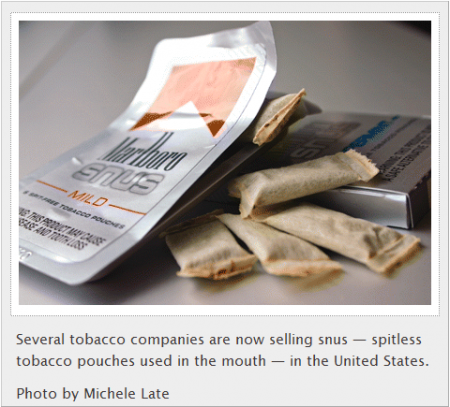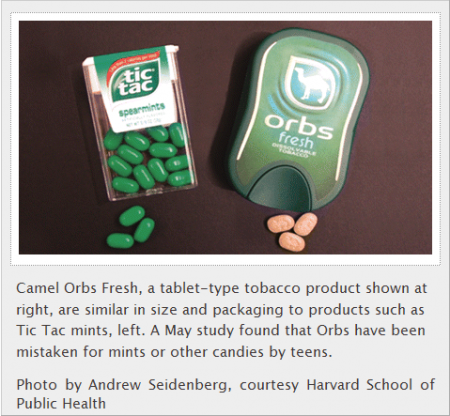Source: thenationshealth.aphapublications.org
Author: Kim Krisberg
The decline in the U.S. smoking rate is arguably one of the biggest achievements in the nation’s public health history. But as public health makes inroads, the tobacco industry is pushing back, offering new ways to deliver nicotine and hook lifelong customers.
As nonsmoking ordinances sweep across the country, tobacco manufacturers are marketing new smokeless and spitless tobacco products, often selling them as complementary products to cigarettes — pushing the message that such “novel” tobacco products can deliver a nicotine fix whether smoking is allowed or not.
Going by brand names such as Orbs, Snus and Taboka, the products are smokeless and spitless, often dissolving in a user’s mouth. For example, Marlboro Snus comes in a teabag-like pouch that a user puts between the cheek and gum and then discards after about 30 minutes. Camel Orbs look similar to small pieces of candy — almost like a Tic Tac — come in flavors such as “fresh” and “mellow,” and dissolve in a user’s mouth. Camel Sticks and Camel Strips also dissolve in a user’s mouth. A recent Camel Snus ad reads “Boldly Go Everywhere” and “Break Free.”
While such products have yet to catch on in a significant way in the United States, public health advocates warn not to underestimate the influence of tobacco marketing, especially in regard to young people. They also warn that tobacco companies seem to be portraying the novel products as a “healthier” alternative to cigarettes or as a quitting aid.
“What we have seen is that whenever concerns about tobacco and health increase, the tobacco industry, for decades, has introduced new products in an effort to expand the marketplace and interest non-users,” said Matthew Myers, president of the Campaign for Tobacco-Free Kids. “The new products we’re seeing today — flavorable dissolvable products, heavily marketed smokeless tobacco products — are a continuation of that trend.”
Fortunately, the novel products come under the jurisdiction of the U.S. Food and Drug Administration’s new tobacco regulatory authority, which officially kicked in this June. Originally signed into law by President Barack Obama last year, the law gives FDA authority over tobacco manufacturing, marketing and sales, which means that like cigarettes, novel tobacco products must also come marked with large warning labels and submit to strict advertising rules. However, in an article published in the May issue of Pediatrics, Lawrence Deyton, MD, MSPH, director of FDA’s new Center for Tobacco Products, and Marisa Cruz, MD, also with the center, noted that while FDA’s “framework is being implemented, the landscape is shifting.”
“As state and local communities across the United States adopt indoor clean-air laws that restrict smoking in public areas and workplaces, the tobacco industry seems increasingly focused on the development and introduction of novel smokeless tobacco products,” Deyton and Cruz wrote. “This shift in focus seems to be reflected in the evolving patterns of tobacco use by youth.”
According to data from the Centers for Disease Control and Prevention’s “Youth Risk Behavior Surveillance — United States, 2009” report, which was released in June, almost 9 percent of U.S. students nationwide reported using smokeless tobacco on at least one day in the 30 days prior to the survey — an increase from previous years. In addition, a survey released in May by the Virginia Foundation for Healthy Youth found that one out of three teens surveyed incorrectly identified flavored tobacco as candy. Almost 40 percent of people younger than 18 surveyed identified Camel Orbs Fresh as mints or candy based on its packaging, and among respondents who did not currently use tobacco, 27 percent said they would try Orbs based on the packaging.
Camel Orbs Fresh, a tablet-type tobacco product shown at right, are similar in size and packaging to products such as Tic Tac mints, left. A May study found that Orbs have been mistaken for mints or other candies by teens.
Photo by Andrew Seidenberg, courtesy Harvard School of Public Health
Myers at the Campaign for Tobacco-Free Kids noted that the novel products’ popularity “depends largely on whether the tobacco industry succeeds in creating an image for those products.” He added that when tobacco manufacturers introduced Skoal Bandit, a product similar to Snus, in the early 1980s, few youth were using smokeless tobacco products. But within a few years, it became a fad among young people, especially among young male teens.
“The time to stop the spread of dangerous products is before they become the fad of today,” Myers told The Nation’s Health.
FDA’s Tobacco Products Scientific Advisory Committee is set to begin its review of new dissolvable tobacco products that are shaped and flavored like candy. Earlier this year, the agency sent letters to tobacco manufacturers requesting information on the perception and use of such products and about the health consequences of their misuse. Besides being a serious oral health risk, dissolvable products such as Orbs, Sticks and Strips pose a poisoning risk to children. In fact, in April, some members of the U.S. Senate called on FDA to immediately recall the products from the market.
“It was clear from the very beginning that tobacco candy was de-signed and marketed to appeal to children,” said Sen. Jeff Merkley, D-Ore. “Now we have clear evidence that children are not only obtaining these candies, they are being poisoned by them.”
Such evidence was published in the May issue of Pediatrics. A study examined almost 14,000 tobacco product ingestion cases, 70 percent of which involved infants younger than 1. The study found that smokeless tobacco products were the second-most common tobacco products ingested by children, and such products represent an increasing proportion of tobacco ingestion among children younger than 5. The study noted that compared to cigarettes or moist snuff, novel products such as the candy-like Orbs contain a higher amount of un-ionized nicotine — the form of nicotine most rapidly absorbed in the mouth — which may enhance the product’s toxicity.
Gregory Connolly, DMD, MPH, a co-author of the study and director of the Tobacco Control Research Program at the Harvard School of Public Health, said that even though novel tobacco products typically do not contain as much nicotine as cigarettes, they create the desire for cigarettes — “it’s no accident that these have the same brand names as conventional cigarettes.” But while novel products pose their own dangers, smoking remains the biggest threat, he said.
“We should keep our eye on the ball and that’s conventional cigarettes,” Connolly told The Nation’s Health. “Those are the killers.”
Cheryl Healton, DrPH, president and CEO of the American Legacy Foundation, the organization that created the successful youth anti-smoking campaign known as “truth,” said the biggest threat from novel tobacco products are their “gateway” effect, helping to create youth who are “no longer nicotine naive and move on to more dangerous products.”
Luckily, she said the same prevention tactics employed by the truth campaign — educating youth that they are “being used by adults (in the tobacco industry) to make a profit” — can also be applied to products such as Orbs and Snus.
“These novelty products represent an entryway into the tobacco market and young people who try them are much more likely to go on to smoke cigarettes,” Healton said. “So, they’re not to be ignored.”
For more information on public health concerns surrounding the new smokeless tobacco products, visit www.tobaccofreekids.org or www.legacyforhealth.org.




Leave A Comment
You must be logged in to post a comment.